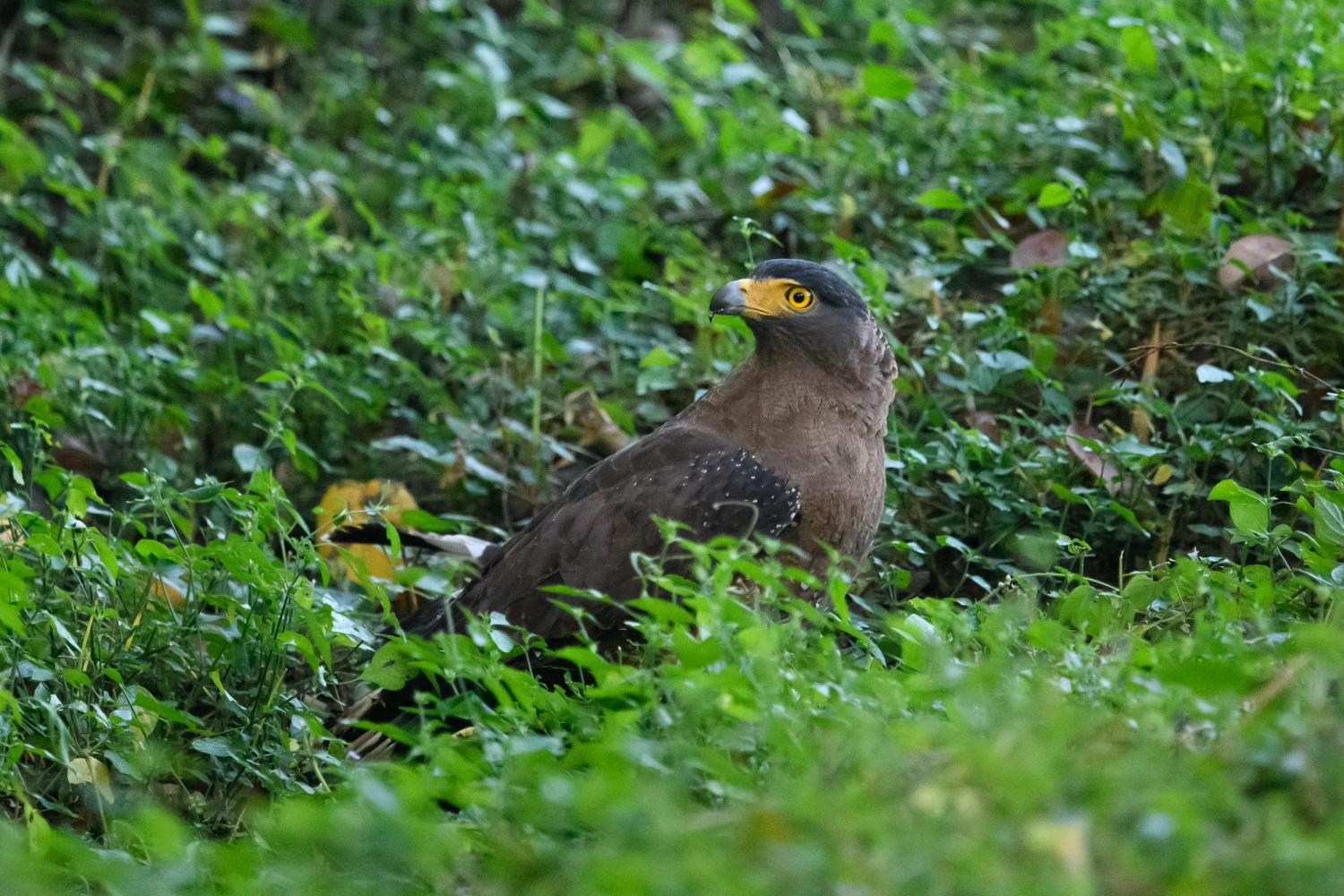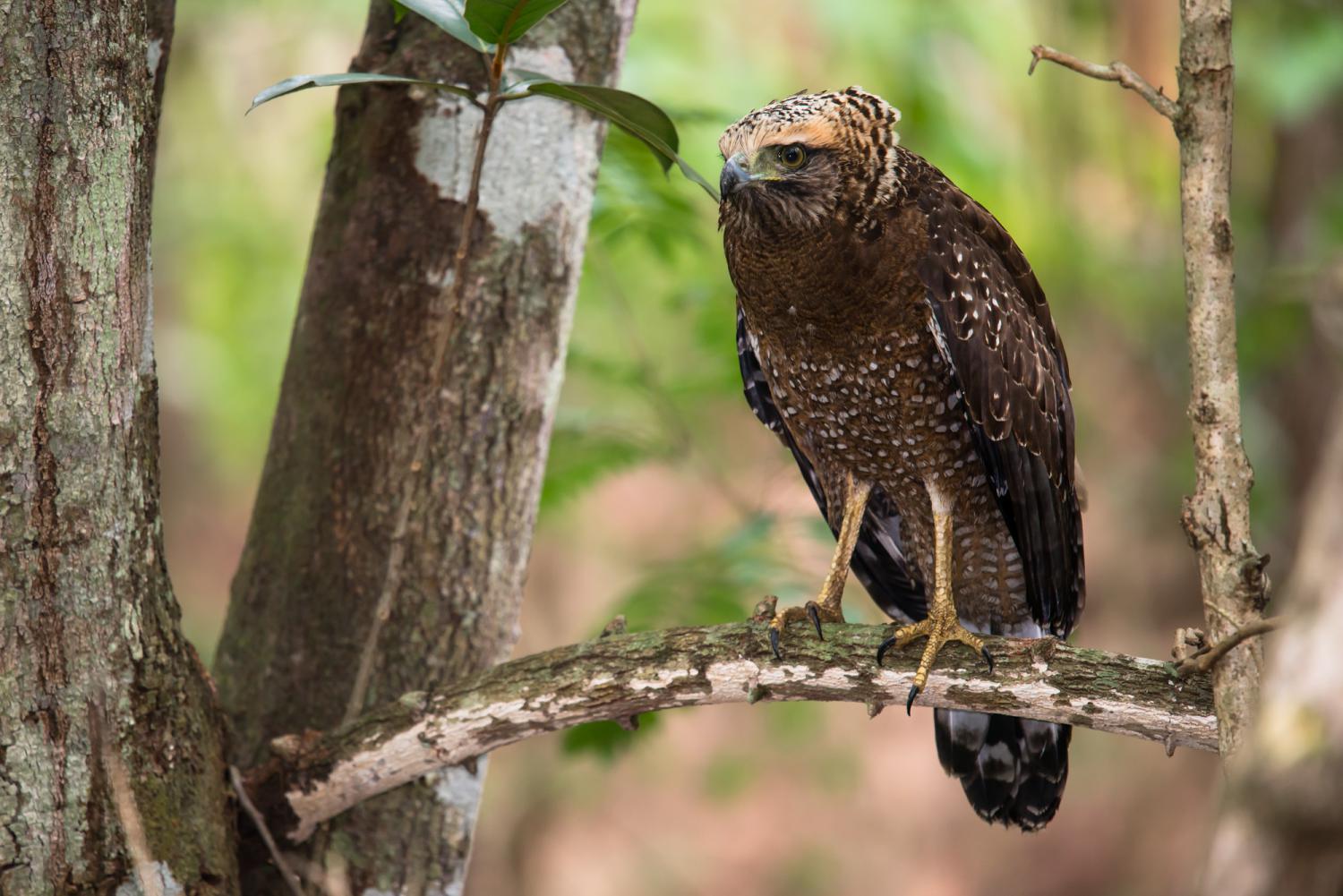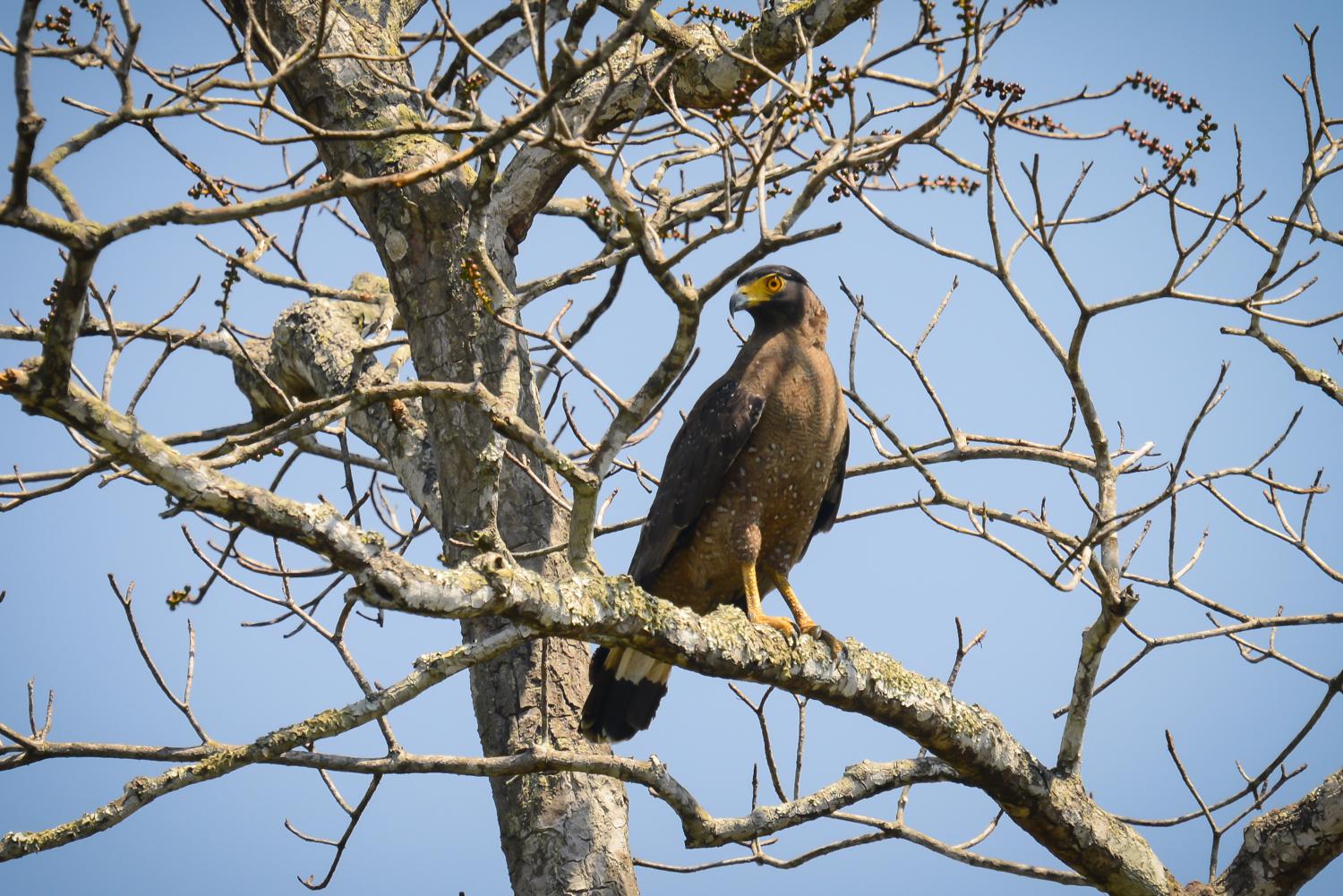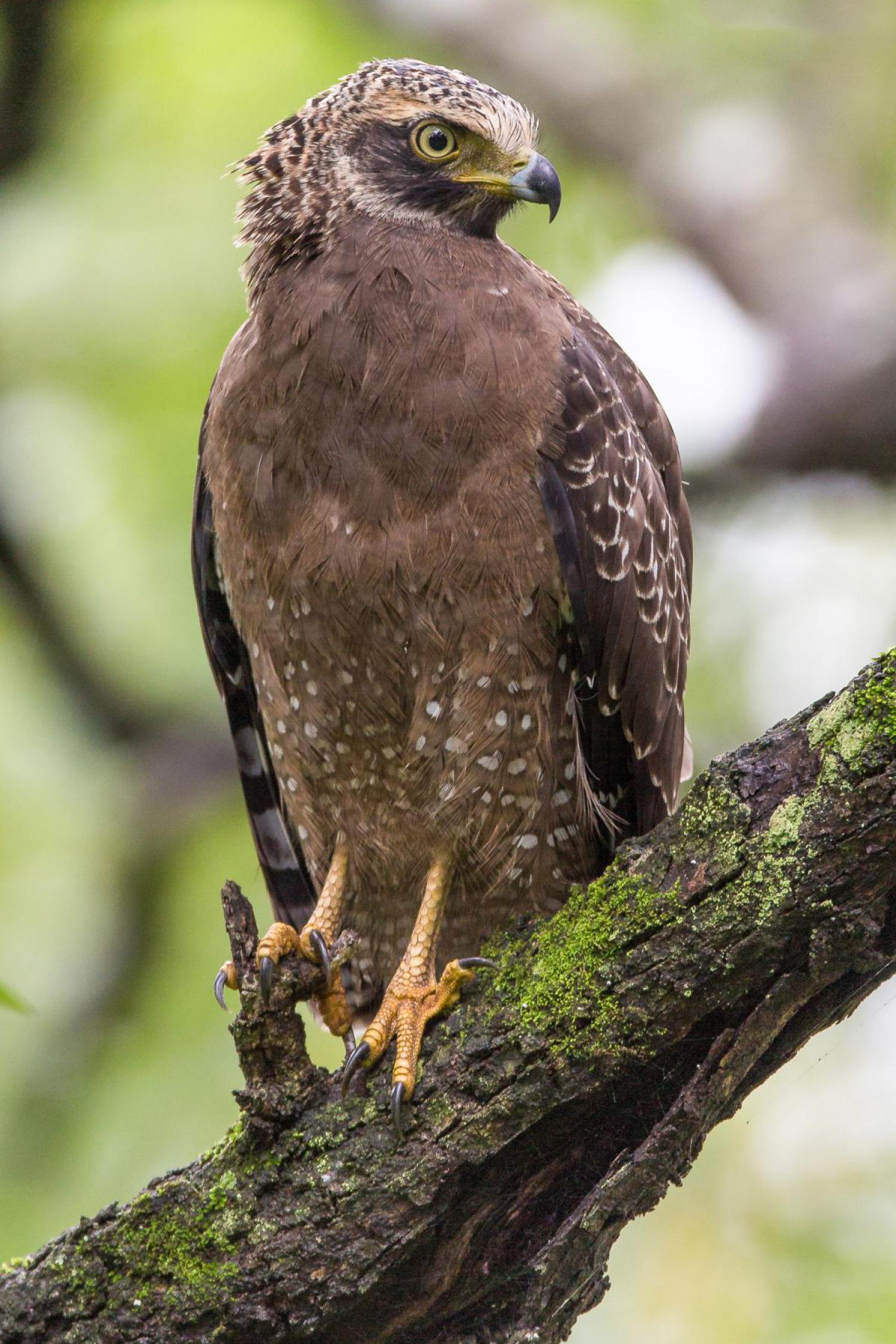Species of Thailand
Crested serpent eagle
Spilornis cheela
John Aubrey Clarendon Latham, 1790
In Thai: เหยี่ยวรุ้ง
The crested serpent eagle (Spilornis cheela) is a medium-sized bird of prey that is found in forested habitats across tropical Asia. Within its widespread range across the Indian Subcontinent, Southeast Asia and East Asia, there are considerable variations and some authorities prefer to treat several of its subspecies as completely separate species. In the past, several species including the Philippine serpent eagle (S. holospila), Andaman serpent eagle (S. elgini) and South Nicobar serpent eagle (S. klossi) were treated as subspecies of the Crested serpent eagle. All members within the species complex have a large looking head with long feathers on the back of the head giving them a maned and crested appearance. The face is bare and yellow joining up with the ceres while the powerful feet are unfeathered and heavily scaled. They fly over the forest canopy on broad wings and tail have wide white and black bars. They call often with a loud, piercing and familiar three or two-note call. They often feed on snakes, giving them their name and are placed along with the Circaetus snake-eagles in the subfamily Circaetinae.
Description
This medium-large, dark brown eagle is stocky, with rounded wings and a short tail. Its short black and white fan-shaped nuchal crest gives it a thick-necked appearance. The bare facial skin and feet are yellow. The underside is spotted with white and yellowish-brown. When perched the wing tips do not reach until the tail tip. In soaring flight, the broad and paddle-shaped wings are held in a shallow V. The tail and underside of the flight feathers are black with broad white bars. Young birds show a lot of white on the head. The tarsus is unfeathered and covered by hexagonal scales. The upper mandible does not have an overhanging festoon to the tip.
Distribution, taxonomy and status
Within its widespread range across tropical Asia, 21 populations have been named as subspecies. The most widespread subspecies are the nominate from along the sub-Himalayan range in India and Nepal, melanotis in Peninsular India, spilogaster of Sri Lanka, burmanicus in most of Indochina, ricketti in northern Vietnam and southern China, malayensis of the Thai-Malay Peninsula and northern Sumatra, pallidus from northern Borneo, richmondi from southern Borneo, bido from Java and Bali, batu from southern Sumatra and Batu, hoya from Taiwan, rutherfordi from Hainan, and palawanensis from Palawan. The remaining subspecies are all restricted to smaller islands: davisoni in the Andamans, minimus (Central Nicobar serpent eagle) from the central Nicobars, perplexus (Ryukyu serpent eagle) from Ryukyu, natunensis (Natuna serpent eagle) from Natuna, abbotti (Simeulue serpent eagle) from Simeulue, sipora (Mentawai serpent eagle) from Mentawai, asturinus (Nias serpent eagle) from Nias, and baweanus (Bawean serpent eagle) of the Bawean. The last seven (with English names in brackets) are sometimes treated as separate species. Although the crested serpent eagle remains widespread and fairly common overall, some of the taxa that are restricted to small islands are believed to have relatively small populations that likely are in the hundreds. The rarest is probably the Bawean serpent eagle with a declining population of about 26–37 pairs, which makes it critically endangered.
The nominate subspecies has a black throat while the peninsular Indian form has a brownish throat. There are clinal latitudinal variations, with size decreasing southward. The small islands taxa are generally smaller in size than the taxa from the Asian mainland/larger islands in a phenomenon termed as insular dwarfism.
The specific name cheela is derived from the Hindi name for kites.
Behaviour and ecology
The crested serpent eagle, as its English name suggests, is a specialist reptile eater which hunts over forests, often close to wet grassland, for snakes and lizards. It is placed along with the snake eagles of the genus Circaetus in the subfamily Circaetinae. It is found mainly over areas with thick vegetation both on the low hills and the plains. This species is a resident species, but in some parts of their range they are found only in summer.
The call is a distinctive Kluee-wip-wip with the first note being high and rising. They call a lot in the late mornings from their perches where they spend a lot of time and they rise on thermals in the mornings. In southern Taiwan, males have a larger home range than females. Males on average had a home range of 16.7 km2 while females used about 7 km2. When alarmed, they erect the crest and the head appears large and framed by the ruff. They will sometimes follow snakes on the ground. They roost in the interiors of trees with dense foliage. A radio-telemetric study of the species in Taiwan found that the birds spend 98% of the day perched and usually finding food in the morning hours. They appear to use a sit and wait foraging strategy.
The breeding season begins in late winter when they start courting and establishing territories. The eggs are laid in early summer. Old nests are often refurbished and reused in India but a study in Penang found them to build fresh nests each year. A study in India found that most nests were built along riverine trees. The nest is a large platform built high on a tree. Both birds in a pair build the nest but the female alone incubates. The male guards when the female forages. In central India, the Terminalia tomentosa is often used while Terminalia bellirica and Dalbergia latifolia was often used in southern India. In Penang, the nest trees were typically large and isolated from other trees with lot of room for the birds to fly in and out. The nests are lined with green leaves collected from nearby and are placed facing down on the nest floor. The usual clutch is one egg but two are sometimes laid and only a single chick is successfully raised in a season. When eggs are lost, a replacement is laid two to seven weeks later. The eggs hatch after about 41 days and the young fledge after about two months. Nests are defended by the parents.
Several species of endoparasitic nematodes have been recovered from the intestines of crested serpent eagles including Madelinema angelae Avian pox virus infections which cause warts on the face have been observed in a wild bird living in Taiwan. A number of ectoparasitic bird lice have been described from the species including Kurodaia cheelae. In Penang, it was found that cinereous tits (Parus cinereus ambiguus) tended to nest close to nesting crested serpent eagles, presumably due to safety from predators like crows that may be driven off by the eagles. They have also been found to visit the nests of the eagles to collect fur from the remains of dead mammal prey.
This article uses material from Wikipedia released under the Creative Commons Attribution-Share-Alike Licence 3.0. Eventual photos shown in this page may or may not be from Wikipedia, please see the license details for photos in photo by-lines.
Category / Seasonal Status
BCST Category: Recorded in an apparently wild state within the last 50 years
BCST Seasonal statuses:
- Resident or presumed resident
- Non-breeding visitor
Scientific classification
- Kingdom
- Animalia
- Phylum
- Chordata
- Class
- Aves
- Order
- Accipitriformes
- Family
- Accipitridae
- Genus
- Spilornis
- Species
- Spilornis cheela
Common names
- Thai: เหยี่ยวรุ้ง
Conservation status

Least Concern (IUCN3.1)
Photos
Please help us review the bird photos if wrong ones are used. We can be reached via our contact us page.
Range Map
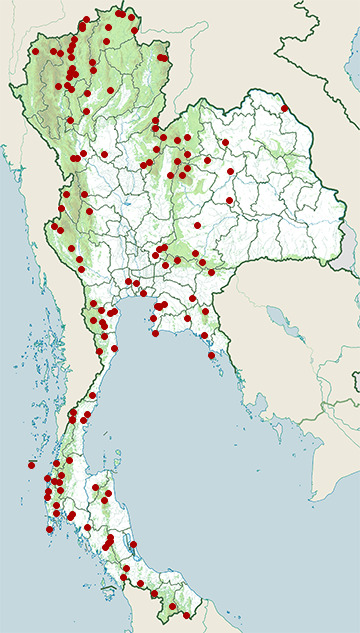
- Ao Phang-Nga National Park
- Ban Bueng District, Chonburi
- Ban Lat District, Phetchaburi
- Bang Lamung District, Chonburi
- Bang Lang National Park
- Bang Phra Non-Hunting Area
- Bang Saphan Noi District, Prachuap Khiri Khan
- Bangkok Province
- Chae Son National Park
- Chiang Dao District, Chiang Mai
- Chiang Dao Wildlife Sanctuary
- Chiang Khong District, Chiang Rai
- Chiang Saen District, Chiang Rai
- Dan Sai District, Loei
- Doi Chong National Park
- Doi Inthanon National Park
- Doi Lang
- Doi Lo District, Chiang Mai
- Doi Pha Hom Pok National Park
- Doi Phu Kha National Park
- Doi Suthep - Pui National Park
- Erawan National Park
- Fang District, Chiang Mai
- Hala-Bala Wildlife Sanctuary
- Hang Chat District, Lampang
- Hua Hin District, Prachuap Khiri Khan
- Huai Kha Khaeng Wildlife Sanctuary
- Huai Nam Dang National Park
- Kaeng Khoi District, Saraburi
- Kaeng Krachan District, Phetchaburi
- Kaeng Krachan National Park
- Kaeng Krung National Park
- Khao Ang Rue Nai Wildlife Sanctuary
- Khao Banthat Wildlife Sanctuary
- Khao Chamao - Khao Wong National Park
- Khao Chong
- Khao Dinsor (Chumphon Raptor Center)
- Khao Khiao - Khao Chomphu Wildlife Sanctuary
- Khao Laem National Park
- Khao Lak - Lam Ru National Park
- Khao Luang National Park
- Khao Nam Khang National Park
- Khao Nan National Park
- Khao Phanom Bencha National Park
- Khao Phra - Bang Khram Wildlife Sanctuary
- Khao Pu - Khao Ya National Park
- Khao Sam Roi Yot National Park
- Khao Soi Dao Wildlife Sanctuary
- Khao Sok National Park
- Khao Yai National Park
- Khlong Nakha Wildlife Sanctuary
- Khlong Phanom National Park
- Khlong Saeng Wildlife Sanctuary
- Khon San District, Chaiyaphum
- Khun Chae National Park
- Khun Nan National Park
- Ko Chang National Park
- Ko Phra Thong
- Kromluang Chumphon Wildlife Sanctuary
- Kui Buri National Park
- Lan Sang National Park
- Mae Mo District, Lampang
- Mae Ping National Park
- Mae Rim District, Chiang Mai
- Mae Taeng District, Chiang Mai
- Mae Wong National Park
- Muak Lek District, Saraburi
- Mueang Chiang Mai District, Chiang Mai
- Mueang Chiang Rai District, Chiang Rai
- Mueang Chumphon District, Chumphon
- Mueang Khon Kaen District, Khon Kaen
- Mueang Krabi District, Krabi
- Mueang Nakhon Nayok District, Nakhon Nayok
- Mueang Phang Nga District, Phang Nga
- Mueang Phetchaburi District, Phetchaburi
- Mueang Phuket District, Phuket
- Mueang Tak District, Tak
- Nam Nao National Park
- Namtok Mae Surin National Park
- Namtok Phlio National Park
- Namtok Sam Lan National Park
- Noen Maprang District, Phitsanulok
- Non Thai District, Nakhon Ratchasima
- Nong Bong Khai Non-Hunting Area
- Nong Song Hong District, Khon Kaen
- Nong Ya Plong District, Phetchaburi
- Op Khan National Park
- Pa Sang District, Lamphun
- Pachee River Wildlife Sanctuary
- Pai District, Mae Hong Son
- Pang Sida National Park
- Pha Daeng National Park
- Phan District, Chiang Rai
- Phu Chi Fa Forest Park
- Phu Foi Lom National Park
- Phu Hin Rong Kla National Park
- Phu Khiao Wildlife Sanctuary
- Phu Kradueng National Park
- Phu Langka National Park
- Phu Luang Wildlife Sanctuary
- Phu Soi Dao National Park
- Phu Suan Sai National Park
- Phu Wiang National Park
- Phutthamonthon District, Nakhon Pathom
- Ramkhamhaeng National Park
- Sadeth Naikrom - Krom Luang Wildlife Sanctuary
- Sai Yok District, Kanchanaburi
- Sakaerat Environmental Research Station
- Samae San Island
- Samut Prakan Province
- San Kala Khiri National Park
- Sangkhla Buri District, Kanchanaburi
- Sathing Phra District, Songkhla
- Si Racha District, Chonburi
- Sri Nakarin Dam National Park
- Sri Phang Nga National Park
- Surin Islands
- Tai Rom Yen National Park
- Taksin Maharat National Park
- Takua Pa District, Phang Nga
- Tat Mok National Park
- Tha Yang District, Phetchaburi
- Thale Ban National Park
- Thap Lan National Park
- Thung Salaeng Luang National Park
- Thung Yai Naresuan Wildlife Sanctuary
- Ton Nga-Chang Wildlife Sanctuary
- Umphang Wildlife Sanctuary
- Wang Mai Forest Restoration Project
- Wang Saphung District, Loei
- Yan Ta Khao District, Trang
